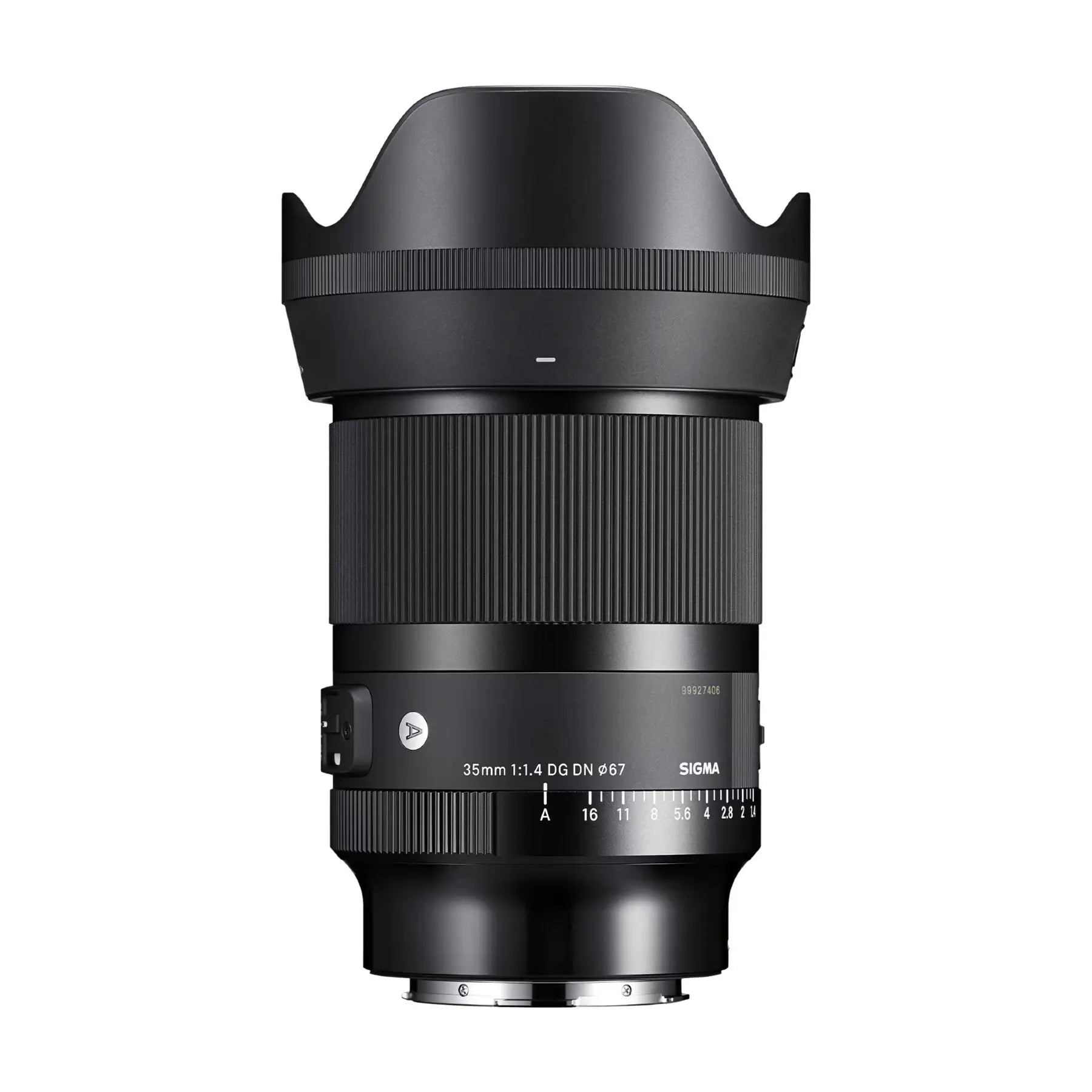Product Description
Introducing the Sigma 35mm F1.4 DG DN - Art
An ultra-sharp and fast wide-standard prime for mirrorless systems.

The Evolution of a Classic
The Sigma 35mm F1.4 DG DN is one of the finest wide-standard primes available for full-frame mirrorless cameras. It combines superior image quality, a fast aperture, rapid autofocus, and a highly versatile focal length, making it an excellent choice for various photography applications, including portraits, landscapes, street, weddings, and travel. The maximum aperture of F1.4 allows photographers to achieve a very shallow depth-of-field, creating impressive subject separation for high-impact results. This lens complements the 24mm, 50mm, and 85mm Art primes, which also feature F1.4 apertures.
With an advanced optical design that includes 15 elements in 11 groups—comprising one F Low Dispersion (FLD) element and four Special Low Dispersion (SLD) elements—the image quality is exceptionally high. The lens delivers pin-sharp results free of chromatic aberration at all aperture settings. Additionally, a Super Multi-Layer Coating reduces ghosting and flare.
The lens features an aperture ring, allowing users to change the aperture on the lens itself rather than through the camera. This ring can be de-clicked and locked for added versatility.
Designed specifically for mirrorless systems, this classic wide-standard prime offers outstanding optical performance and an ultra-wide aperture in a compact package.

Key Optical Features:
- Advanced Optical Construction: 15 elements in 11 groups.
- Low Dispersion Elements: Includes 1 FLD and 4 SLD elements for minimal chromatic aberration.
- Super Multi-Layer Coating: Reduces ghosting and flare.
- Aperture Ring: Allows direct aperture control with de-click and lock options.

Outstanding Build Quality
The Sigma 35mm F1.4 DG DN is crafted with the exceptional build quality typical of the Art line. The exterior barrel is made of Thermally Stable Composite (TSC), which is strong, light, and has a similar thermal expansion rate to aluminium, ensuring uniform behaviour of interior aluminium parts and exterior TSC parts as temperatures change.
The rubberised focus ring ensures easier operation, and the internal focusing mechanism means the lens does not change length, maintaining a constant centre of gravity—ideal for gimbal use. The aperture ring, located towards the rear of the barrel, offers manual or automatic aperture control.
A robust petal-type lens hood with a lock button protects the front element from damage and reduces flare and ghosting in bright sunlight. The durable brass mount is surrounded by a rubber seal to help keep out dust and moisture.

Key Build Features:
- Thermally Stable Composite Barrel: Strong and lightweight.
- Rubberised Focus Ring: Easier and more precise operation.
- Internal Focusing Mechanism: Maintains constant lens length.
- Petal-Type Lens Hood: Provides protection and reduces flare.
- Brass Mount with Rubber Seal: Enhances durability and weather resistance.

Professional Feature-Set
The lens includes an AF/MF switch and a customisable AFL button (depending on the camera model). It also features a click/de-click switch for smooth aperture adjustment, useful for filmmakers, and a lock switch to prevent accidental changes to the aperture ring.
A powerful stepping motor ensures fast, accurate, and quiet autofocus with excellent tracking capabilities.

Key Features:
- AF/MF Switch: Allows quick focus mode changes.
- Customisable AFL Button: Enhances shooting flexibility.
- Click/De-click Switch: Provides smooth aperture adjustments.
- Stepping Motor: Ensures fast and quiet autofocus.
High-Performance Optics
The 35mm F1.4 DG DN | Art boasts outstanding optical quality, with excellent detail rendering right into the corners, even wide open at F1.4. The lens features an advanced optical design with 15 elements in 11 groups, including 2 aspherical elements, 2 SLD elements, 1 FLD element, and 1 ELD element. At its release, it was the only Sigma lens to feature ELD technology. These low-dispersion elements ensure razor-sharp results and eliminate chromatic aberration, flare, distortion, and vignetting.
Advanced optical coatings reduce flare and ghosting in bright sunlight, creating high-contrast images with rich colours and strong blacks.

Key Optical Features:
- 15 Elements in 11 Groups: Ensures superior image quality.
- Multiple Low-Dispersion Elements: Minimises chromatic aberration.
- Advanced Coatings: Reduces flare and ghosting.
Ideal for Low-Light and Close-Up Photography
At F1.4, the lens collects four times more light than an F2.8 optic, making it perfect for low-light photography such as astrophotography and nightscapes. The lens renders exceptional star detail even in shorter exposures, with minimal sagittal coma flare, keeping stars as sharp, bright points of light even in the corners.
Although not a dedicated macro lens, the 35mm is capable of highly detailed close-ups, making it a versatile tool for various shooting scenarios.

Key Features:
- Low-Light Capability: Ideal for nightscapes and astrophotography.
- Exceptional Star Detail: Minimal sagittal coma flare.
- Close-Up Capability: Delivers detailed close-ups despite not being a macro lens.
The Sigma 35mm F1.4 DG DN | Art lens combines exceptional optical performance, outstanding build quality, and a comprehensive feature set, making it an essential tool for both photographers and filmmakers.
Payment & Security
Your payment information is processed securely. We do not store credit card details nor have access to your credit card information.



















